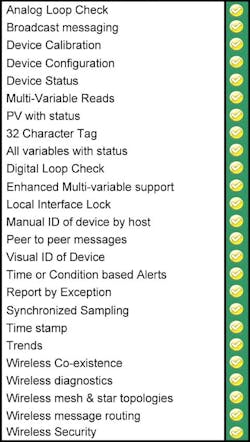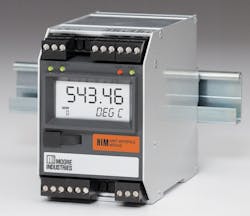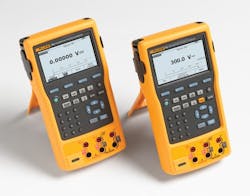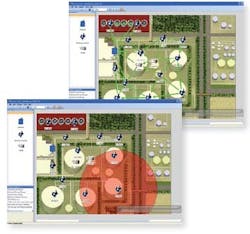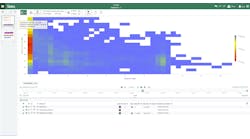Do more with less. That's the mantra of many industries today in North America or anywhere else around the globe. Companies no longer have employees that aren't fully utilized—nobody has a couple of hours to grab a clipboard and some test equipment and go out in the plant to check the condition of field devices and final control elements.
Besides, plants require hot work permits, safety information, workarounds and other time-consumers, making it highly unproductive to grab that clipboard and go.
Companies around the world have begun formal programs to use the diagnostic data in their HART-smart instruments and control valve actuators and positioners by directly connecting them to the asset management systems in the maintenance department.
"HART technology has saved both time and money," says Todd Gordon of We Energies in Milwaukee, Wis. "We have also used the HART signal from digital valve controllers (DVCs) or positioners to provide valve position to our DCS control system with the use of a HART converter module."
Why was this important? "Actual position feedback was not available with the original plant equipment, and we couldn't tell if a valve was sticking without physically looking at it," Gordon says. "With this HART signal converted to 4-20 mA for an input to DCS, we then added a deviation alarm to tell the control operator when the DCS command signal deviated from the actual valve position more than 5% for more than five seconds. This HART feature alone saved the plant from tripping offline on several occasions. We have been able to adjust valve packing on valves when they were in service, which is a huge benefit. We have also prioritized maintenance work based on the friction calculations of the HART smart positioners. The dampers with the highest friction numbers were repaired first."
Figure 1: Get connected to all of this valuable diagnostic data that you already own.
Hiren Choksi, of Krishak Bharti Cooperative Limited in Gujarat, India, agrees. "Benefits are quite huge in terms of the monetary aspect, as well as it has helped by increasing the overall productivity of the plant. Let's say, in an ammonia plant, one unplanned breakdown shortens the life of reformer tubes by 7% due to thermal shocks. Using the HART protocol, faults and errors are able to be identified and rectified well in advance."
Tina Lockhart, director of engineering for Moore Industries International, says, "Every HART field device response contains information regarding the device's health. This information consists of device and variable status, such as device malfunction or primary variable out of limits. Having this data sent with every message provides the operator with confidence in the integrity of the process measurement and with immediate notification of a problem. From a maintenance perspective, a whole plant can be monitored from a single location, and fault diagnosis can often be performed remotely. Many instruments provide additional status information that can be used for predictive maintenance and replacement of equipment on an as-needed basis. This results in reduced maintenance trips, fewer process disruptions and high system availability."
Eddie Saab of Lakeside Process Controls in Ontario, Canada, talks about the use of HART diagnostics to correct serious problems at the Bruce Nuclear Power Station. "This is the largest nuclear power plant in North America," he says."Bruce Power had a history of feedwater heater operating problems. When a comprehensive root-cause analysis was initiated in 2001, it pointed to two main causes for the problems: an inverted loop in the saturated drains that allowed liquid to collect (which was corrected), and inadequate heater level control, which was solved using HART-enabled smart instrumentation."
Saab continues. "The Bruce Power/Lakeside process controls team decided to carry out what it called "smart utilization of smart equipment." Solenoids and junction boxes were integrated onto the valve assemblies. An interlock was tied in so that if power was lost to the solenoid, the positioner air supply was blocked, and the valve actuator used its spring to get the valve to the fail-safe position. The team used the HART signal inherent in the Fisher DVC6000 digital positioner to detect the solenoid trip. And, finally, the team set up the Fisher DVC6000 digital positioner on the valve to provide a direct signal for valve position and to enable on-line valve diagnostics."
Moving to Predictive Maintenance
"This approach uses two-way communication between the control room and the valve for on-line troubleshooting," Saab continues. "On-line troubleshooting is looking for advance signs of problems that could impact process performance. This allows the plant to move away from preventive maintenance, typical within the industry, and toward true predictive maintenance, a more effective way to address valve and process problems."
Kenneth Marse, of Galata Chemicals LLC in Taft, La., puts the value of HART for asset management simply. "The plant converted to contract instrumentation/electrical maintenance in 2007, and staffing was significantly reduced. Instrument reliability suffered, and calibration compliance declined. Using HART and the AMS system [from Emerson Process Management], the site has improved instrument reliability and has returned to full calibration compliance while maintaining a reduced staff."
Figure 2: Online fault diagnosis made easy with HART
AMS is just one of the asset management software packages that easily uses both HART process and diagnostic information. Nearly all of the major CMMS (computerized maintenance management software) and automation-vendor-based packages provide native support for HART devices.
We know, from talking to our customers," says Kaoru Sonoda of Yokogawa Electric Corporation, "just how much time and money can be saved with good predictive maintenance systems. With the widespread use of HART instruments, connecting existing and future HART devices into both the control system like our CENTUM and the asset management system like our PRM (Plant Resources Management) can be critical to realizing those benefits." Sonoda adds, "And the FieldMate Device Management Tool allows for easy device configuration and troubleshooting"
Interoperability and Backward Compatibility
We Energies' Todd Gordon notes, "Valley Power Plant has been using HART smart instrumentation since the late 1980s. The transmitter loop test function has been used for troubleshooting and insurance compliance testing of the boiler trip functions. HART smart valve positioners have been used since 1999, and they have provided valuable diagnostic capabilities that have allowed us to troubleshoot problems while the valves are in operation. It also helps to pinpoint problems before mechanics start taking valves apart. A leaking valve diaphragm that has been identified with diagnostics can be replaced without removing the valve, which saves time and money. We have found numerous problems before they affected plant operations."
Gordon adds, "Other power plants in our company have adopted HART technology over the years. The older Oak Creek Power Plant added an AMS on-line system when they installed wireless transmitters on their feedwater heaters for performance monitoring. Pleasant Prairie started using digital valve controllers in 2003, has an online AMS system and recently added some WirelessHART transmitters to their systems."
Gordon says HART interoperability is transparent. "Two new plants were built in the last few years by two different contractors (Washington Group & Bechtel)," he says, "and both plants came standard with on-line HART technology to communicate with the HART smart instrumentation in the plant."
Save Time and Money on Calibration and Diagnostics
Galata's Marse says, "Our plant is using AMS Intelligent Device Manager and HART to monitor diagnostic alerts and for calibration management to reduce maintenance time and maintain calibration compliance. The central system links real-time HART data and instrument documentation in a single system which provides a single source for the I/E technician."
Figure 3: Documenting Calibrators with HART connectivity make calibration rounds easy
Without the ability to enter calibration data directly into the asset management system, the data that is collected about the actual condition of the instruments other than the HART diagnostic data is suspect.
Jim Shields, product manager for calibrators for Fluke, points out, "Several surveys have shown that paper-and-pencil documentation produces and perpetuates errors. Further, as maintenance and operations departments have less and less time and fewer employees, much of the data collected on clipboards will just be filed and not used. In addition, entering this manually collected data into CMMS systems is also a manual operation, taking time, costing money and usually far down the list of things that must be done to keep the plant operating and producing revenue. That's why the new Fluke 754 Documenting Calibrator has HART connectivity. Both sets of data can be documented and uploaded directly to the CMMS."
Just how much money can you save using HART diagnostics? "On-line diagnostics provided by the HART instruments does something more than preventive maintenance," says József Bartók, automation engineer at MOL Danube Refinery in Hungary, adding that this "ensures the stable operation of the system and increases the precision of control." Beyond fixing what breaks or keeping the plant running, a reliable, stable operation contributes to bottom-line profitability.
On-line and off, HART has proved its mettle according to Bartók.
In one case, the head pressure control was slow on one unit leading to the assumption that a valve was stuck and in need of removal and repair. But technicians with on-line diagnostic tools used HART-supplied data to interrogate the valve and find current-to-pneumatic damage only in the intelligent positioner–not the whole valve.
Operators put the valve in manual, and the fix took a half hour of instrumentation work. This saved the plant at least two days of unscheduled downtime, or approximately €637,000 ($897,790 USD).
Savings, increased throughput, reduced downtime—spell it any way you want. You already have all the data you need to gain savings like MOL did—in your HART instruments.
Figure 4: WirelessHART device networks can be designed easily with this visual network manager
Wired or Wireless—HART's the SameEngineers and operators who are familiar with how to connect HART to their control and asset management systems are finding IEC62591-WirelessHART a breeze to add to their systems. Each WirelessHART transmitter behaves exactly like its wired counterpart. This is thanks to the interoperability and interchangeability specifications designed into the HART and WirelessHART specification from the beginning. The biggest difference between the two is that there are no wires.
We Energies added an asset management system (Emerson's AMS Suite) and WirelessHART sensors, according to Gordon, "when they installed wireless transmitters on their feedwater heaters for performance monitoring." The AMS Suite has what is called a "snap-in" module that performs network management and device site selection for wireless instruments and final devices.
No matter what vendor's brand of HART or WirelessHART devices you use, you can be assured of a simple and easy way to improve your asset management—with tools you already have. So get connected with HART right now!

Leaders relevant to this article:

